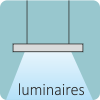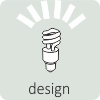A luminaire is a complete lighting unit, comprised of a light source (lamp or lamps), together with the parts that distribute the light, position and protect the lamps, and connect the lamps to the power supply. Good luminaire can distribute light well, separate task lighting with ambient lighting, provide controllability, etc. Choosing luminaires that efficiently provide appropriate luminance patterns for the application is an important part of energy efficient lighting design. One of the main current and future research trend is innovation in luminaire to enhance the lighting experience and ensure design flexibilities in different functional requirements. The reflectivity of the material and the maintenance factor of luminaire is dependant on the material selection and robust design.
Luminaires Performance
A performance of a luminaire is significant for estimating the energy efficiency of the overall lighting system and design. It is defined in terms of light output ratio (LOR), i.e. the ratio of lumens emitted by the luminaire to lumens emitted by that luminaire’s lamps. The efficiency of a luminaire is subject to the lamp type, control gears, optical components, and material of reflective surface. High reflective surfaces have improved the LOR enabling the luminaire to transfer more than 70% of lamp output.
For an efficient design, LOR is considered along with the room index to estimate the co-efficient of utilization. The CU accounts not only for light losses within the luminaire, but also for the effects of room configuration and surface reflectance. Each lamp type and luminaire manufacturer have different co-efficient of utilization for their product. Better the ratio, lesser the number of luminaires required in a space to lit the area as per the desired lux level. Most general lighting luminaire manufacturers provide co-efficient of utilization data for different room index value for their respective luminaire product. In case where, the co-efficient of utilization ratio of less than 0.5, it is recommended to either upgrade the light source to more efficient lamps or use controls for indirect reduction of lighting capacity.














